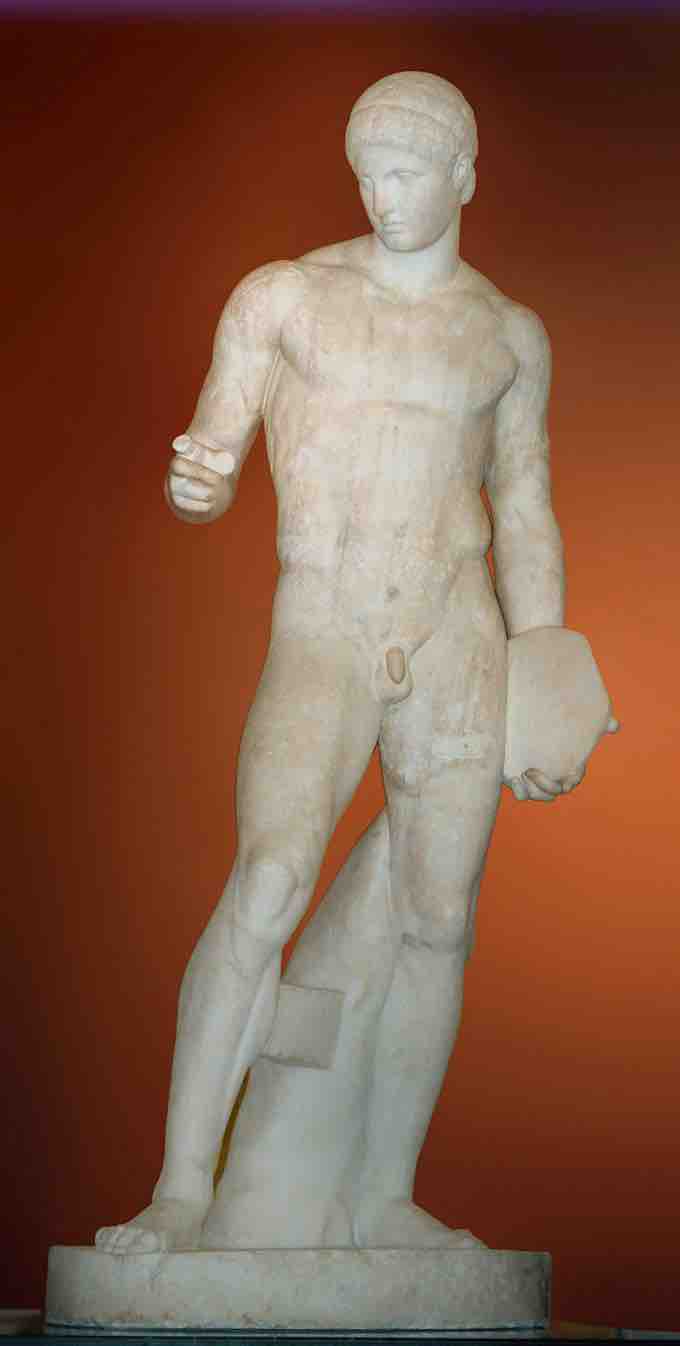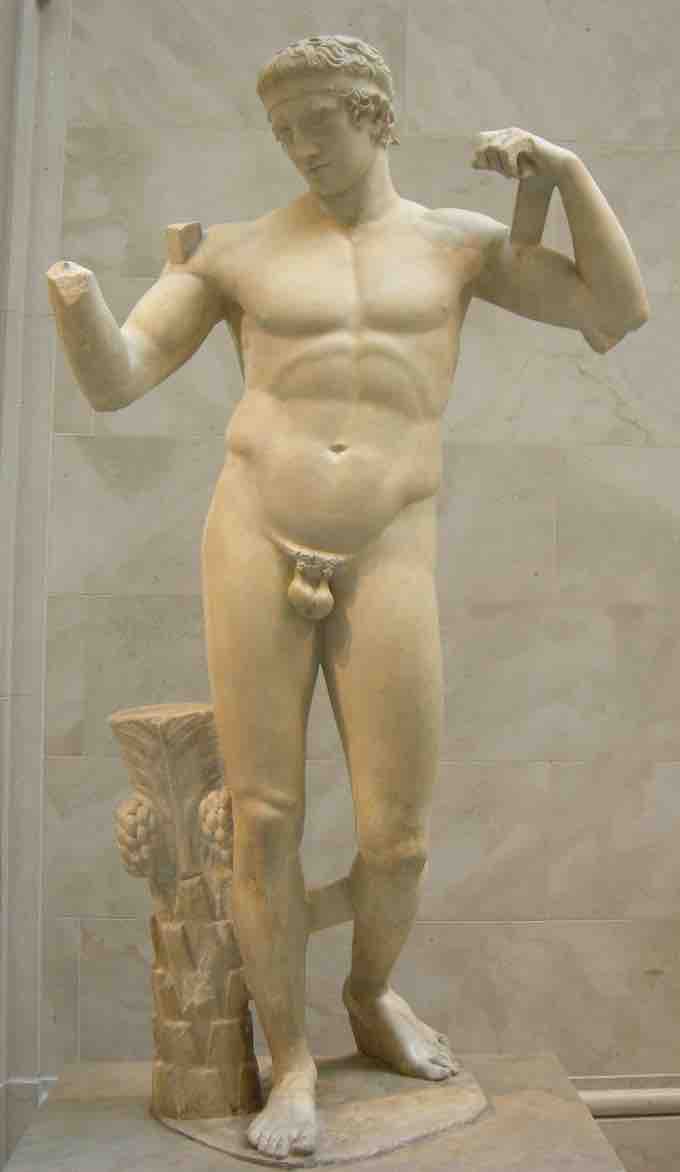Polykleitos
Polykleitos was a famous Greek sculptor who worked in bronze. He was also an art theorist who developed a canon of proportion (called the Canon) that is demonstrated in his statue of Doryphoros (Spear Bearer) Many of Polykleitos's bronze statues from the Classical period, including the Doryphoros, survive only as Roman copies executed in marble. Polykleitos, along with Phidias, is thought to have created the style recognized as Classical Greek sculpture.
Another example of the Canon at work is seen in Polykleitos's statue of Diadumenos, a youth trying on a headband and his statue Discophoros, a discus bearer. Both Roman marble copies depict athletic, nude male figures. The bodies of the two figures are idealized. The nudity allows the harmony of parts, or symmetria, to easily be seen, illustrating the principles discussed in the Canon. The Canon focused on the proportion of parts of the body in relationship to each other to create the ideal male form. Both statues demonstrate fine proportion, ideal balance, and definable parts of the body.

Polykleitos. Discophoros
Roman marble copy of a Greek bronze original c. 440 BCE.

Polykleitos. Diadoumenos
Roman marble copy of Greek bronze original c. 430 BCE.
The athletes are shown in contrapposto stances. The Discophoros shifts his weight to his left leg. His hips and the slightly forward lean toward his right leg exaggerate the weight shift. The figure is balanced on his left leg, which is drawn back, and the rest of his body appropriately responds to this stance. The Diadumenos also stands in contrapposto, although his movement seems more forward and stable than that of the Discophoros. He ties on a band that identifies him as a winner in an athletic contest. His raised arms add a new dynamic component to the composition.
The Discophoros and Diadumenos, along with the Doryphoros, demonstrate the flexibility of composition based on the Canon and the innate liveliness produced by contrapposto postures. Despite the lively aspects and unique poses of the figures, all three still retain the Severe style and expressionless face of early Greek sculpture. Polykleitos not only worked in bronze but is also known for his chryselephantine cult statue of Hera at Argos, which in ancient times was compared to Phidias's colossal chryselephantine cult statues.
Phidias
Phidias was the sculptor and artistic director of the Athenian Acropolis and oversaw the sculptural program of all the Acropolis's buildings. He was considered one of the greatest sculptors of his time, creating monumental cult statues of gold and ivory for city-states across Greece. Phidias is well known for the Athena Parthenos, the colossal cult statue in the naos of the Parthenon. While the statue has been lost, written accounts and reproductions (miniatures and representations on coins and gems) provide us with an idea of how the sculpture appeared. It was made out of ivory, silver, and gold and had a wooden core support. Athena stood crowned, wearing her helmet and aegis. Her shield stood upright at her left side and her left hand rested on it while in her right hand she held a statue of Nike. An artist's reconstruction is housed in the Parthenon in Nashville.
Reconstruction of Phidias's Athena Parthenos.
The Parthenon. Centennial Park. Nashville, TN.
Before he created the statue of Athena Parthenos for Athens, Phidias was best known for his chryselephantine statue of Zeus at Olympia, which was considered one of the wonders of the world. The statue of Zeus at Olympia is said to have been 39 feet tall chryselephantine statue. As with Athena Parthenos, not much is known for sure about how the statue looked, although written accounts and marble and coinage copies provide possible ideas. Besides being built on a colossal scale, reports indicate that the figure of Zeus was seated, holding a scepter and a statue of Nike. An eagle was perched either at his side or on his scepter. Besides being decorated with gold and ivory, the sculpture was further embellished with ebony and previous stones. An artist's conception of the colossal sculpture resides in the Hermitage Museum in St. Petersburg, Russia.
Reconstruction of Phidias's Zeus at Olympia.
Hermitage Museum. St. Petersburg, Russia.
Myron
The Athenian artist Myron also produced bronze sculptures during the mid-fifth century BCE. His most famous work is of the Diskobolos, or discus thrower (not to be confused with Polykletios's discus bearer Discophoros). The Diskobolos shows a young, athletic male nude with a Severe-style face. His body holds a contrapposto pose; one leg bears his weight, while the other is relaxed. A relaxed arm balances his body and the other arm tenses, preparing to let go of the disc. The Diskobols demonstrates a dynamic, chiastic composition that relies on diagonal lines to move the eye about the sculpture.

Myron. Diskobols.
Roman marble copy of a Greek bronze original c. 450 BCE.
This figure represents another new element in Classical sculpture -- the illustration of the potential for energy. His energy appears wound up, waiting for the figure to release it. The statue depicts a swift and transitory moment and that is frozen at a precise moment to exhibit the harmony, balance, and rhythm perfected by both the athlete and the artist.